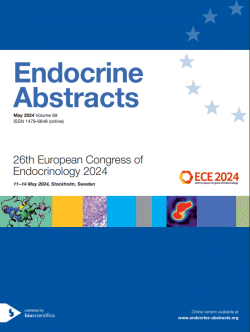
26th European Congress of Endocrinology
Stockholm,
Sweden
11 May 2024 - 14 May 2024

Oral Communications
Oral Communications 12: Diabetes, Obesity, Metabolism and Nutrition | Part II
ea0099oc12.1 | Oral Communications 12: Diabetes, Obesity, Metabolism and Nutrition | Part II | ECE2024
Loss of murine Gpr45 leads to significant obesity due to hyperphagia and hypoactivity
Mumal Iqra , Min Soo , Lee Diana , Trenish Jacob , Pryce Dwaine , Gomez Daniel , Na Erqian , Bigdelou Parnian , Altarejos Judith , Sleeman Mark , Mastaitis Jason
ea0099oc12.2 | Oral Communications 12: Diabetes, Obesity, Metabolism and Nutrition | Part II | ECE2024
Intestinimonas butyriciproducens as a new preventive therapy for type 2 diabetes: a proof of concept randomized controlled trial
Antoniotti Valentina , Caputo Marina , Mollero Edoardo Luigi Maria , Antonioli Alessandro , TIni Sabrina , Manfredi Marcello , Bona Elisa , Pane Marco , Amoruso Angela , De Prisco Annachiara , Gul Sahin , Bui Nam , Seegers Jos , De Vos Willem M , Aimaretti Gianluca , Prodam Flavia
ea0099oc12.3 | Oral Communications 12: Diabetes, Obesity, Metabolism and Nutrition | Part II | ECE2024
Growth hormone promotes in-vivo hepatic triglyceride export in humans
Baumgartner Clemens , Metz Matthaeus , Pfleger Lorenz , Tosin Anna , Beghini Marianna , Beiglboeck Hannes , Fellinger Paul , Schnait Franziska , Vila Greisa , Luger Anton , Kautzky-Willer Alexandra , Freudenthaler Angelika , Baumgartner-Parzer Sabina , Stangl Herbert , Krssak Martin , Scherer Thomas , Krebs Michael , Wolf Peter
ea0099oc12.4 | Oral Communications 12: Diabetes, Obesity, Metabolism and Nutrition | Part II | ECE2024
Characteristics and outcomes of DKA in people taking SGLT2 inhibitors: DEKODE study
Mathur Nitish , Sharma Angelica , Philip Nevil , Rengarajan Lakshmi , Bomphrey Lucy , Abraham Anu , Saraf Sanjay , Dhatariya Ketan , Kempegowda Punith , Working Group Dekode
ea0099oc12.5 | Oral Communications 12: Diabetes, Obesity, Metabolism and Nutrition | Part II | ECE2024
The effects of semaglutide vs testosterone replacement therapy on functional hypogonadism and sperm quality in men with type 2 diabetes mellitus and obesity
Gregoric Nadan , Sikonja Jaka , Janez Andrej , Jensterle Mojca
ea0099oc12.6 | Oral Communications 12: Diabetes, Obesity, Metabolism and Nutrition | Part II | ECE2024
Efficacy and safety of postbiotic supplementation for type 2 diabetes patients: Randomized clinical Ttrial (DELI Diab study)
Savytska Maryana , Baka Olena , Manzhalii Elina , Kyriienko Dmytro , Falalyeyeva Tetyana , Sichel Liubov , Kobyliak Nazarii



